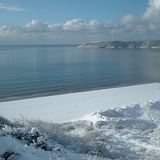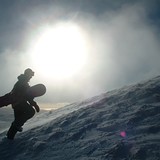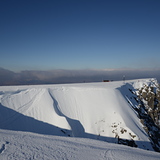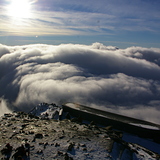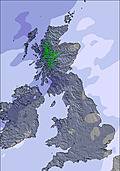 Ski United Kingdom
Ski United Kingdom
The UK is one of the world’s more unusual ski nations. The country has five conventional ski areas – all in Northern Scotland, but also small ski club hills run mostly by volunteers and enthusiasts on the hills and dales of Wales and Northern England and there is also occasional skiing on hills in Northern Ireland. At a third level of British skiing, England and Scotland have six year-round indoor snow centres – the same number as Germany, equal third in number behind the Netherlands and Japan for that kind of ski slopes and finally on a fourth level there are around 60 artificial surface dry slopes spread across the country where people can ski all year on a dry surface which may occasionally have snow for a few weeks in total each winter.
This unusual mix of ski areas – almost all running on marginal economic business models – reflects the obsessions Brits have with winter sports which permeates far beyond the UK’s national shores as about a million Brits head to ski slopes around the world each winter.
Scotland’s five ski centres were mostly established in the first half of the twentieth century with skiers hiking up in order to ski down ungroomed slopes. The first lift making it easier to ski Scotland – believed to be the world’s first detachable chairlift – was installed at Cairngorm above Aviemore in 1961. The unusual lift by modern standards ascended with chairs sideways on to the slope. It caught the attention of the Queen’s husband, the Duke of Edinburgh, staying in nearby Balmoral Castle, who visited it soon after opening, thus focusing media attention on Aviemore and helping to kick start a period of several decades when Scottish skiing was the most popular option for Brits, before Austria and most recently France took over as international travel became easier.
Scottish skiing is a fairly unusual option compared to the majority of resorts. Like the rest of the UK the region is subject to the warming winds of the Gulf Stream, and Atlantic weather is usually dominant, making the region warmer than it should be for its latitude. These warm conditions alternate with periods when colder weather arrives sometimes from mainland Europe and most dramatically from the Arctic. The result is that the ski slopes can receive heavy snowfalls and build up bases metres deep, but then at any time of the winter and with little warning, the temperature can shoot up in to double digits and melt it all away within days.
For this reason attempts to add snowmaking have been problematic, although most of the centres have one or two snowguns now, because it can be too warm to make snow or machine made snow melts as fast as the natural stuff when it has been made.
The slopes are also often exposed to strong wind, with Britain’s biggest ever gust recorded at Cairngorm at over 180mph (nearly 300kph) which, when combined with cold, can mean high wind chill factors. The mountainsides are criss-crossed with extensive ‘snow fencing’ designed to stop snow from blowing off the mountainside.
It’s also worth noting that conditions are often very different on one side of the country to the other. Nevis Range and Glencoe Mountain Resort are on the West Coast (both offer some of the most spectacular scenery in world skiing) while the other three (Cairngorm, Glenshee and The Lecht) are on the East. Although conditions are most commonly good (or bad) at all five, sometimes the resorts on one side are good and the other side bad – even though they are in fact only a few dozen miles apart as the crow flies.
The result of this is that when conditions are good each winter the slopes are very busy – particularly at weekends and in holiday periods – and can get crowded. The ideal is to visit mid-week, off peak when you can have a superb day on the uncrowded slopes and won’t have to queue to park, rent equipment, buy tickets or board the lifts – which are, incidentally, almost all drag lifts with an additional funicular railway at Cairngorm, a gondola at Nevis Range and a chairlift or two at the other centres.
Whatever the conditions Scottish skiing is always friendly with great camaraderie and a famous sense of British etiquette that makes queue jumping a definite no no accompanied by much tutting if anyone tries it.
Perhaps because of the challenges Scottish ski areas face, overcome by their always dedicated staff, when you do get a good day on fresh snow under a blue sky with no wind and empty slopes, Scottish skiing can be the best in the world.
In any case, although booking a Scottish ski holiday long in advance of knowing what the conditions are like is always going to be something of a gamble, the area does have a massive range of alternative attractions including Loch Ness, wildlife parks with tigers and polar bears, theme parks, steam railways, indoor water parks, dolphin-spotting boat trips, great golf courses, whisky distilleries and all kinds of mountain and water sports available year round, so there’s always plenty to do and even when conditions aren’t great the centres can usually open limited terrain. And Nevis Range and The Lecht have dry slopes for beginners.
Weather conditions at the Northern English, Welsh and Northern Irish ski hills are much the same and ski lifts there are set up to make the most of areas with a long history of holding snow as temperatures warm. Most involve walking up through the snow to what is normally a fairly basic single ski lift. Many have been operating since the early years of the sport with the Lake District Ski Club celebrating 75 years for the 2011-12 season and building its first slopeside toilet to commemorate the achievement – carrying every part of the facility, including a large septic tank, up the mountainside by hand.
United Kingdom: latest snow conditions round-up
Summary of forecast snowfall and ski conditions for resorts in United Kingdom. Fresh snow is forecast at 5 resorts. Powder is reported at 0 resorts and 0 are reporting good piste conditions.
All resorts
Ski resorts of United Kingdom, alphabetically
| Resort |
|
snow depth top and bottom |
on-piste |
off-piste |
Last Snow |
Next 9 Days 0–3 | 3–6 | 6–9 snow (cm) |
Freezing level (m) |
||||||||||||||||||||||||||||||
|---|---|---|---|---|---|---|---|---|---|---|---|---|---|---|---|---|---|---|---|---|---|---|---|---|---|---|---|---|---|---|---|---|---|---|---|---|---|
| Sat | Sun | Mon | Tue | Wed | Thu | Fri | |||||||||||||||||||||||||||||||
|
(479 m — 539 m) snow report 27 days ago |
|
|
|||||||||||||||||||||||||||||||||||
|
(282 m — 358 m) |
|
|
|||||||||||||||||||||||||||||||||||
|
(549 m — 1097 m) snow report today |

|
|
|
||||||||||||||||||||||||||||||||||
|
(634 m — 725 m) snow report 21 days ago |
|
|
|||||||||||||||||||||||||||||||||||
|
(0 m — 536 m) |
|
|
|||||||||||||||||||||||||||||||||||
|
(305 m — 1108 m) snow report today |
|
|
|||||||||||||||||||||||||||||||||||
|
(654 m — 1029 m) snow report today |
|
|
|||||||||||||||||||||||||||||||||||
|
(607 m — 686 m) snow report 22 days ago |
|
|
|||||||||||||||||||||||||||||||||||
|
(570 m — 710 m) snow report 22 days ago |
|
|
|||||||||||||||||||||||||||||||||||
|
(91 m — 1221 m) snow report today |
|
|
|||||||||||||||||||||||||||||||||||
|
(276 m — 886 m) snow report 23 days ago |
|
|
|||||||||||||||||||||||||||||||||||
|
(725 m — 829 m) snow report 8 days ago |
|
|
|||||||||||||||||||||||||||||||||||
|
(825 m — 978 m) snow report 8 days ago |
|
|
|||||||||||||||||||||||||||||||||||
|
(327 m — 1089 m) snow report 8 days ago |
|
|
|||||||||||||||||||||||||||||||||||
|
(640 m — 823 m) snow report today |

|
|
|
||||||||||||||||||||||||||||||||||
|
(488 m — 655 m) snow report 22 days ago |
|
|
|||||||||||||||||||||||||||||||||||
|
(600 m — 725 m) snow report 22 days ago |
|
|
|||||||||||||||||||||||||||||||||||
